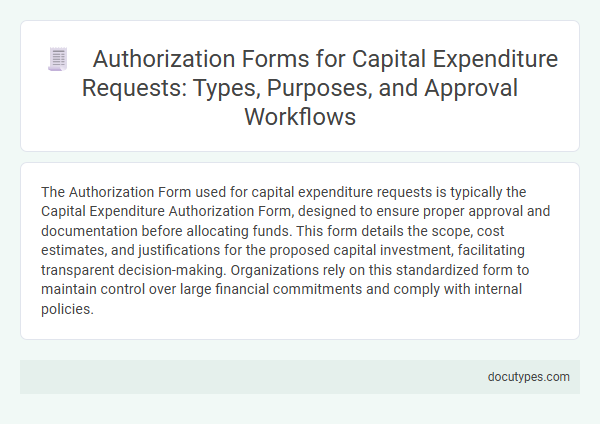The Authorization Form used for capital expenditure requests is typically the Capital Expenditure Authorization Form, designed to ensure proper approval and documentation before allocating funds. This form details the scope, cost estimates, and justifications for the proposed capital investment, facilitating transparent decision-making. Organizations rely on this standardized form to maintain control over large financial commitments and comply with internal policies.
Introduction to Capital Expenditure Authorization Forms
| Topic | Description |
|---|---|
| Capital Expenditure Authorization Forms | Specialized documents used to approve and manage requests for capital expenditures within an organization. These forms ensure that large investments, such as equipment purchases or infrastructure upgrades, receive proper review and authorization. |
| Purpose | To provide a structured process for requesting approval of capital expenditures, aligning spending with organizational budgets and strategic objectives. |
| Key Components |
|
| Common Types of Authorization Forms | Capital Expenditure Request Form, Investment Approval Form, Budget Approval Form |
| Approval Workflow | Submission - Review by Finance and Management - Approval or Rejection - Documentation and Record-Keeping |
Key Purposes of Authorization Forms in CapEx Requests
Authorization forms used for capital expenditure (CapEx) requests are essential to ensure proper approval before committing company resources. These forms verify that proposed expenditures align with budgetary constraints and strategic priorities.
Key purposes of authorization forms in CapEx requests include documenting approval from designated management personnel, ensuring compliance with internal financial policies, and providing a clear audit trail for accountability. They help in controlling spending by requiring justification for the requested capital investment. Proper authorization reduces financial risk and supports sound decision-making within the organization.
Types of Authorization Forms for Capital Expenditure
Authorization forms for capital expenditure requests are crucial for managing company resources and ensuring financial accountability. Different types of forms are used depending on the scale and purpose of the expenditure.
- Standard Capital Expenditure Authorization Form - This form is used for regular approval of expenses related to asset purchases and investments.
- Project-Specific Authorization Form - Tailored for large projects, this form includes detailed budget breakdowns and milestone approvals.
- Emergency Capital Expenditure Form - Used for urgent or unforeseen expenses requiring immediate authorization to avoid operational delays.
You should select the authorization form that aligns with the nature and urgency of your capital expenditure request to streamline approval processes.
Essential Components of CapEx Authorization Forms
The authorization form used for capital expenditure (CapEx) requests is specifically designed to evaluate and approve large investment projects. Essential components of CapEx authorization forms include detailed project descriptions, estimated budgets, and approval signatures from designated financial authorities. This ensures clear documentation, accountability, and compliance with organizational financial policies.
Standard Approval Workflows for Capital Expenditure
The authorization form used for capital expenditure requests is typically the Capital Expenditure Authorization Form (CEAF). This form ensures all proposed expenses undergo a standardized review process aligned with organizational policies.
Standard approval workflows for capital expenditure involve multiple levels of authorization, including department heads, finance teams, and senior management. These workflows streamline decision-making, ensuring expenditures align with budgetary constraints and strategic priorities.
Roles and Responsibilities in CapEx Authorization
Which authorization form is used for capital expenditure requests? The Capital Expenditure Request Form (CapEx Form) is the standard document utilized. This form ensures all necessary approvals and budget validations are documented.
What roles are involved in CapEx authorization? Key roles include the Project Manager, Finance Controller, and Senior Management. Each role is responsible for validating costs, assessing project feasibility, and granting final approval.
How does the CapEx authorization process ensure accountability? The structured form captures role-specific approvals and signatures. This process maintains transparency, budget control, and compliance with corporate policies.
What responsibility does the Project Manager hold in CapEx authorization? The Project Manager initiates the request by detailing project scope and estimated costs. They provide justification and ensure alignment with strategic goals.
What role does Finance play in capital expenditure approvals? Finance reviews budget availability and cost accuracy. Their approval confirms financial feasibility and adherence to fiscal policies.
How is Senior Management involved in CapEx authorization? Senior Management reviews high-value requests for strategic alignment. Their approval is critical for capitalization and resource allocation decisions.
Documenting and Tracking CapEx Approvals
Capital expenditure requests require a formal authorization form to ensure proper documentation and approval tracking. Using a dedicated CapEx authorization form helps maintain clear records of all approvals related to significant financial investments.
- Capital Expenditure Authorization Form - This standardized document captures detailed information about the proposed investment, including cost estimates and justification.
- Approval Workflow Tracking - The form integrates with digital systems to monitor each stage of review, ensuring transparency and accountability in the approval process.
- Audit Trail Maintenance - Proper completion and storage of the authorization form create a reliable audit trail for future reference and compliance verification.
Common Challenges in CapEx Authorization Processes
Capital expenditure requests typically require a Capital Expenditure Authorization Form, designed to document project details, budget estimates, and approval signatures. Common challenges in CapEx authorization processes include delays due to incomplete forms, lack of standardized evaluation criteria, and insufficient communication between departments. Streamlining the approval workflow and implementing digital authorization platforms can help mitigate these issues and ensure timely decision-making.
Best Practices for Effective CapEx Authorization Forms
Capital expenditure (CapEx) authorization forms are essential for managing large financial investments efficiently. Using the right form ensures clear communication and proper approval workflows.
- Detailed Project Description - Clearly outline the scope and purpose of the capital investment to avoid misunderstandings.
- Cost Breakdown - Include itemized expenses and total estimated cost to maintain budget transparency.
- Approval Hierarchy - Specify required approvers and their roles to streamline the authorization process and ensure accountability.
Which Authorization Form Is Used for Capital Expenditure Requests? Infographic

